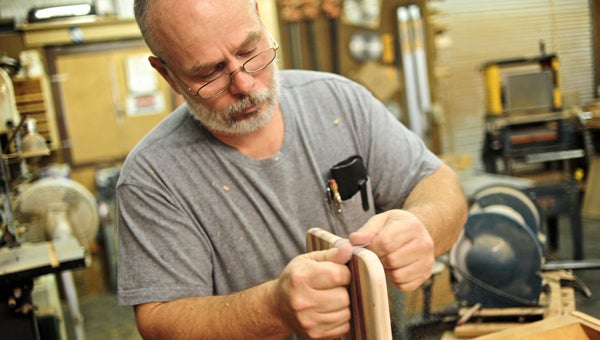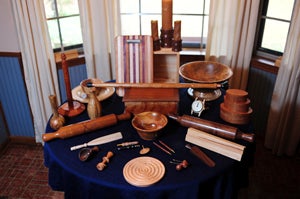
By Emily Beckett
The wedges of wood about the size of watermelons sitting on the floor of Clanton native Gerald Smitherman’s workshop look like prime candidates for a log fire in his fireplace.
The jagged bark and roughly cut chunks of lumber seem as ordinary as the trees outside Smitherman’s woodworking domain, but what Smitherman sees when he looks at the blocks are the smooth wooden bowls he plans to make from them.
“I’m thinking that there’s something pretty inside that,” he said. “I accentuate the beauty of the wood. God put that there. How do I get it out and accentuate it?”
The answer to his question is found in the hours Smitherman spends in the shop most days, turning the wood and chiseling it into evenly round bowls and then buffing out the remaining impurities with a super-fine abrasive compound.
Bowls are not the only items Smitherman makes. His extensive collection of wooden items—not including those he has given away to family and friends—fills his and his wife Tammy’s home.
“You can probably just look around and see all of his work,” Tammy Smitherman said. “When they (our children) find something they like, they just bring him a picture and he just builds it from a picture. He can build any style and from a picture, which is amazing to me.”
Smitherman sketches pieces prior to constructing them if they are requests from friends, and he jots down mathematical calculations and measurements for larger pieces of furniture with multiple parts that fasten together.
For many pieces, however, he follows the blueprints in his head, the instincts of his hands and the passion in his heart.
“I love the entire process,” Smitherman said. “I love the smell of wood, the look of wood, everything about woodworking, and I always have. I’ve always been fascinated with that.”

Before he retired in November 2011, Smitherman was an agriscience teacher at Isabella High School for 22 years and taught basic woodworking.
More importantly, he hails from a line of men who passed down to him at a young age their affinity for woodwork in various capacities.
Smitherman’s father, James Earl, operated a cabinet shop when Smitherman was a teenager and eventually began building musical instruments such as violins and fiddles.
Smitherman’s grandfather, R.E., was a carpenter and basket maker later in life.
“With my granddaddy and my dad, I was always raised and we’ve always kind of lived on the philosophy: ‘Don’t buy anything if you can build it. Don’t hire anybody to do anything that you can do yourself,’” Smitherman said. “Everybody knows at Christmas they’re getting something made out of wood.”
One of the most significant projects Smitherman undertook was constructing his and Tammy’s craftsman-style bedroom suite from red oak, his favorite species of wood particularly for furniture.
“At some point I really got interested in what they call ‘craftsman,’ or Arts and Crafts style,” Smitherman said. “The wood that was always used in this furniture was quarter-sawn red oak.”
The craftsman style originated in the early 1900s and is characterized in furniture by simplicity of design and slats on headboards and chairs.
The Smithermans’ bedroom suit includes a bed, a mule chest (a taller version of a dresser), two nightstands and a library table. It took him about two months of working nearly all day, every day, to complete everything.
Smitherman said much of the wood he uses for his projects comes from Hardwoods Inc. of Alabama LLC in Alabaster.
The other portion is reclaimed wood from old or fallen lumber on his property or that of a family member or friend.
“A lot of friends call us and say, ‘I’ve got a tree. Do you want it?’” Tammy said.
From oak to cherry to walnut to maple, Smitherman incorporates a variety of tree types in his items.

He makes cutting boards, candleholders, vases, clocks, playing card holders, seam rippers, rolling pins, jewelry boxes, ink pens, fan pulls, walking sticks, door stops, spatulas, trivets and more.
“For smaller items, I try to choose woods that have natural beauty and don’t need a stain,” he said. “If it’s an item connected to food, I’ll use a food-safe finish. Different projects require different finishes for different purposes.”
Baby rattles merit a coating of shellac since it is safe to use on items children might put in their mouths.
Smitherman creates the smaller items through a method called “turning,” which involves securing a piece of wood between two adjustable prongs on a device known as a lay and holding a chisel against the wood to shape it as it turns on the lay.
After Smitherman is satisfied with the turning, he begins the buffing process using a felt buffing wheel and an abrasive compound that when applied to the item produces “a glass-smooth finish.”
Large items like tables require making a series of parts from rough lumber, fastening the parts together with wood glue, sanding the entire piece until its surface is smooth, applying however many necessary coats of a finish and allowing it to dry.
Tabletops require varnish to withstand hard use and potential damage.
“I do take a lot of pains in doing good finishes,” Smitherman said. “The joinery is very time-consuming.”
While Tammy works as a reading coach at Isabella, Smitherman said he averages six to eight hours a day in his shop in the months he isn’t helping his son Josh on his farm.
For Smitherman, woodworking is a creative outlet and a way to eliminate life’s frustrations.
“We had a running joke (that) if I got snappy, she’d tell me to go turn a rolling pin,” he said. “(It is) a wonderful stress reliever.”
